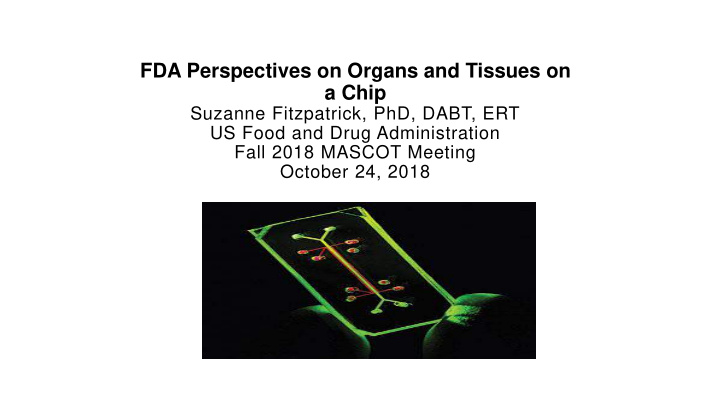



FDA Perspectives on Organs and Tissues on a Chip Suzanne Fitzpatrick, PhD, DABT, ERT US Food and Drug Administration Fall 2018 MASCOT Meeting October 24, 2018
FDA Priorities for Advancing Regulatory Science FDA can close these gaps and improve preclinical safety predictions by further investing in three particular areas of regulatory science: • evaluating and developing models and assays that better predict patient response • identifying and evaluating more reliable biomarkers for monitoring toxicities, side effects, and abnormalities, and • using computational tools to integrate and draw conclusions from a wide range of preclinical safety data 2 types and sources .
Challenges Humans Do Not Predict Humans In Vitro • Usually not fully differentiated • Immune systems, blood flow, etc. not fully represented • Does not represent population, lacks genetic variability Animal Testing • Some species better than others • Two species better than one • Not all toxicities identified in animals • Using normal animals Grignolo and Pretorius, Phase III Trial Failures: Costly, But Preventable. Applied Clinical Trials 25 , 2016
Advancing Regulatory Science • FDA-NIH Joint Leadership Council formed in 2010 • Issued RFA for Advancing Regulatory Science through Novel Research & Science- Based Technologies Program ($7M, 4 awards): Accelerating Drug & Device Evaluation through Innovative Clinical Trial Design o Replacement Ocular Battery o Heart-Lung Micromachine for Safety and Efficacy Testing o Characterization/Bioinformatics-modeling of Nanoparticle: Complement Interactions o
Heart-Lung Micromachine • The microfluidic microdevice mimics the complex structural interfaces and functionalities of the alveolar-capillary interface of the living human lung. • Using this model to look at medical counter- measures • Compare to NIH whole animal studies 5
DARPA-FDA-NCATS Microphysiological Systems Program • Started in 2011 to support the development of human microsystems, or organ “chips,” to screen for safe and effective drugs swiftly and efficiently (before human testing) • Collaboration through coordination of independent programs Engineering platforms and biological proof-of-concept (DARPA-BAA-11- 73: Microphysiological Systems) Underlying biology/pathology and mechanistic understanding (RFA-RM-12-001 and RFA RM-11-022) Advise on regulatory requirements, validation and qualification This was a unique partnership because it involved regulatory scientists at the very beginning to address identified gaps in knowledge need to regulate FDA products.
Microphysiological Systems DARPA – BAA-11-73 • Reconfigurable platform • Ten or more in vitro physiological systems • Able to monitor resident tissues for up to 4weeks • Uses human cells • Commercial availability • Includes plan for validating integrated platform performance • 70 million over 5 years • Applications jointly reviewed by DARPA, FDA, and NIH • Contracts were awarded to Wyss and MIT 7
Stem/Progenitor Cell-Derived Human Micro-organs and -tissues (U18) • GOAL: Develop stem- and progenitor-derived cell resources to seed circulatory, endocrine, gastrointestinal, immune, integumentary, musculoskeletal, nervous (including eye), reproductive, respiratory and urinary microsystems. • SCOPE/ACTIVITIES: o Improvements in differentiation efficiencies towards cell- type diversity, genetic complexity, population diversity, and disease modeling o Development of 3D culturing approaches to enhance cellular microenvironments
Integrated Microphysiological Systems for Drug Efficacy and Toxicity Testing (UH2/UH3) • GOAL: Develop in vitro microphysiological systems representative of major organs/tissues in the human body, that will facilitate the assessment of biomarkers, bioavailability, efficacy, and toxicity of therapeutic agents prior to clinical trials. • SCOPE/ACTIVITIES: o Multicellular architecture representative of the tissue of origin o Functional representation of normal human biology o Reproducible and viable operation under physiological conditions maintained up to 4 weeks in culture o Capacity for representation of normal and disease phenotypes, o Capacity for representation of population diversity o Amenable to high content screening for repeated dose efficacy testing, and for toxicology, and safety screening
Microphysiological Systems Program “Tissue Chips” GOAL: Develop an in vitro platform that uses human tissues to evaluate the efficacy, safety and toxicity of promising therapies. • All ten human physiological systems will be functionally represented by human tissue constructs: • Circulatory • Musculoskeletal • Endocrine • Nervous • Gastrointestinal • Reproductive • Immune • Respiratory • Skin • Urinary • Physiologically relevant, genetically diverse, and pathologically meaningful. • Modular, reconfigurable platform. • Tissue viability for at least 4 weeks. • Community-wide access.
To receive the rest of the presentation, please get in touch at info@hansonwade.com regarding the 3D Tissue Models Summit. We’ll be delighted to send you the full slide deck asap. We look forward to hearing from you! Kind regards, The PREDiCT Team
Recommend
More recommend